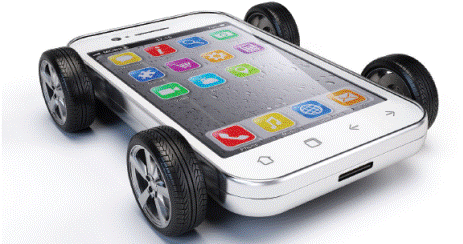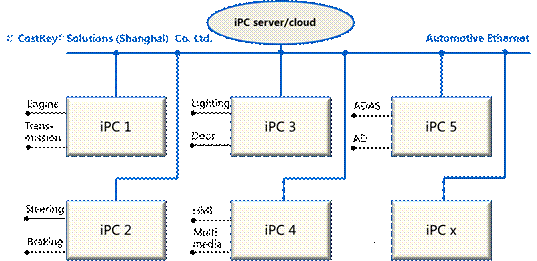This is the electronic and electrical architecture of a mid-level luxury car. As shown in Figure 1, it is a parallel network composed of different bandwidths and signal transmission standards (protocol) and connected by a gateway (Gateway). There is CAN ( controller area network), FlexRay, MOST, LIN, LVDS (Low voltage differenTIal signaling), and even direct connection of analog signals.
Figure 1 EE architecture of a luxury car
There are already tens of thousands of signals in the vehicle electronic network under different transmission standards (protocol), different forms of software run on different hundreds of electronic control modules, the scale of the software has exceeded 100 Mio. Line, how to control such The complex system effectively validates its overall function and safety, and at the same time, it must control the cost of research and development and the entire vehicle within a certain range. This is a huge challenge for OEMs now.
Let ’s review the development of personal computers. Since IBM invented the PC in August 1981, the hardware architecture of the computer is basically fixed and scalable, with CPU, GPU, PCI-Bus, There are ports USB, VGA, HDMI, as well as working memory, hard disk or SSD; software, there is an operating system, there are different application software, and the network connecting these PCs is Ethernet (Ethernet).

The author here points out that the electronic modules of automobiles have the following huge differences compared to PCs:

Faced with the Internet of Vehicles (V2X), ADAS (advanced driver assistance system), electrificaTIon, and autonomous driving in the future, the existing electronic and electrical architecture of automobiles can no longer meet the future Demand. A large amount of data (radar, lidar, camera, and other various sensor signals, as well as V2X signals) need to be received, processed, and issued corresponding instructions to the actuator.
In this regard, the author makes the following three points:
First: Develop and formulate a standard, scalable automotive computer, call it iPC (in-vehicle computer)
iPC is like a high-performance, scalable PC, with standard CPU (central processing unit), GPU (graphic processing unit), SoC (system on chip), and other scalable AI chips, such as NPU (neuronal network processing) unit). In 2000, I was also in charge of the powertrain electronic system of the German Daimler Group. When I discussed the future of automotive electronics with my colleagues, I had the prototype of the iPC idea.
The operating system of iPC can be unified, such as Linux. The network port of iPC is mainly Ethernet (Ethernet), with a bandwidth of 1 Gbps to 100 Gbps, which integrates the future 5G mobile network and I / O ports. This is a century opportunity for PC and server manufacturing companies and innovative technology companies! It is also a moment for the automotive electronics industry to reshuffle!
Second: Develop and implement automotive Ethernet (automoTIve ethernet)
Ethernet has been widely used in the Internet, personal computers, and industrial automation. In the future, Made in China 2025, or German Industry 4.0, the Internet of Things (Internet of Things), they all have a common carrier Ethernet! The reason why the automotive network has rarely used Ethernet (except for a few applications in multimedia), one of the main obstacles is the real-time capability of Ethernet (real TIme capability).
Ethernet generally has to wait for a signal packet (package) that is transmitted first to arrive before it can transmit the second signal packet. In this way, the control signals for the engine, steering, or braking system cannot meet the requirements. In order to enable Ethernet to be time-triggered (time trigged), IEEE802.3 sets standards to send express packages. It can suspend signal packages in transit first, so that the express signal packages can be delivered in real time before being transmitted. The suspended signal package to solve the real-time control problems of the engine, steering and braking system. In addition, if PoE (Power over Ethernet) is used, some actuators can be directly driven without additional wiring harness.
Third: Development of hardware-independent application software
There are various kinds of in-vehicle electronic control modules, because they come from different Tie1, have different hardware, different operating systems, and different application software. This is a very high cost, high risk, for OEM. Very complicated integration and verification work.
If you have an in-vehicle computer iPC and an iPC unified operating system, you can give software technology companies a huge opportunity to develop hardware-independent application software, just like an App, which can run normally in different hardware environments. Customers It can even be paid for downloading (new business model) according to individual needs, which also allows OEMs to simply integrate, verify, and re-use. Some of my colleagues in the German OEM (BBAP) also want to have hardware-independent application software, which is convenient for further development, re-use (re-use), and even easy to switch Tie1.


The future architecture of automotive electronics will be automotive ethernet.
The author makes three points here:
1) Standardized and scalable on-board computer iPC
2) Unified operating system (such as Linux)
3) Hardware independent application software
This will be the future trend of automobile development, and it will bring new business opportunities to PCs, server manufacturers, technology innovation companies, and independent software technology companies. Breaking the monopoly of the system Tie1 is the century opportunity for Chinese parts companies!
It is predicted that by 2025, the penetration rate of Ethernet in automotive electronics will exceed 50%, and it will bring not only a leap in technology, but also cost reduction, light weight and personalization of cars (iPC App, software update OTA), car Networked V2X, a new breakthrough in routing & map via cloud.
Author Dr. Liu Xiaoyi (founder of GuanKey Electromechanical Technology (CostKey-Solutions.com)), Germany Daimler Group (Benz) 21 years of senior automotive technology experience (powertrain electronic control system series development and commercial vehicle electronic architecture design , Vehicle planning, cost engineering, new technology development, gearbox production and other senior managers), led the development of Mercedes-Benz car heavy truck 16-speed automatic gearbox series development, new technology development of powertrain components and large Airbus structural parts, Electric vehicle commercial vehicle and cost planning, multiple key cost reduction projects for commercial vehicles and cars (PKO / OPTIMA, CTX, CORE). The Great Wall Automobile Technology Center served as the senior technical manager for the Great Wall Motor Group, which established the first fully-constructed cost engineering system, method and process for Chinese auto companies, and integrated it into the entire product process of the Group.
Fiber Optic Connector,Fiber Connector,Fiber Termination,Fiber Adapter
Huizhou Fibercan Industrial Co.Ltd , https://www.fibercan-network.com